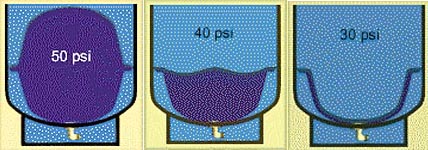
Tanks are sized according to the flow capacity of the pump, with enough drawdown to allow the pump to be off for a minimum of one minute between run cycles, letting the motor cool, as recommended by the motor manufacturers. A 10 gpm pump would require a pressure tank with 10 gallons of drawdown and so on.
There are two types of pressure tanks - captive air tanks (also called pre-charged, diaphragm or bladder tanks) and conventional tanks (also known as hydro-pneumatic, galvanized, ASME and epoxy lined tanks). Using the term hydro-pneumatic to describe a conventional tank is a bit of a misnomer. All pressure tanks used in the ground water industry are hydro-pneumatic meaning they contain water (hydro) and air (pneumatic). In this article, we will use the terms "captive air" and "conventional" to differentiate the two types of tanks.
The largest commonly available captive air tank has a total capacity of 119 gallons. The size of a pre-charged tank is limited by federal highway regulations which require special permits to transport pressurized tanks having a capacity of 120 gallons or more. The drawdown or usable water available from a 119 gallon tank operating in conjunction with a 30/50 pressure switch is 36.8 gallons according to Boyles Law. Referring to the one-minute run time between cycles mentioned above, a 36 gpm pump would be the largest pump you could use with such a tank. What do you do then if you have a larger pump? There are several options.


Plumbing a multi-tank system
It is very important that a multi-tank system be plumbed properly to work properly. The most common mistakes made on these systems involves the placement of the pressure switch and the sizing of the interconnecting manifold. The two basic rules to follow are: 1) Make sure all the tanks see the same pressure while the pump is running. 2) Make sure the pressure switch sees the same pressure as the tanks. To comply with the first rule, use a large enough manifold pipe to assure the flow velocity does not exceed 6 feet per second. This will keep the pressure drop to a minimum from one end to the other and help assure uniform pressure in the entire tank system.To comply with the second rule, place the pressure switch as close to the center of the tanks as possible. Figures 2 and 3 illustrate proper pressure switch placement.
When properly designed and installed, the use of multiple residential-type pressure tanks in a larger high capacity system offers a viable alternative to a single large conventional pressure tank. Next time you need more tank capacity, give this alternative some consideration.

Report Abusive Comment